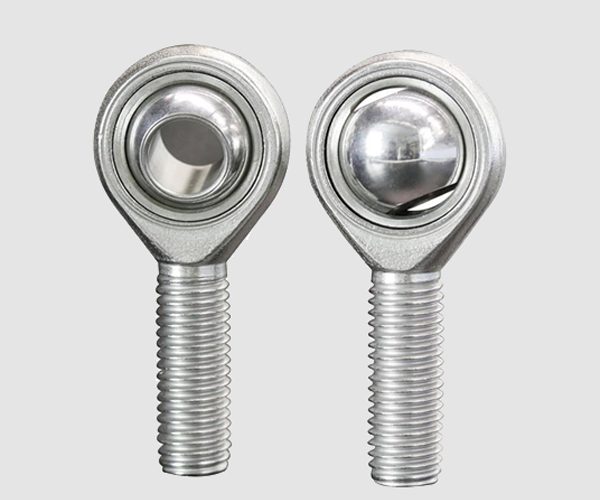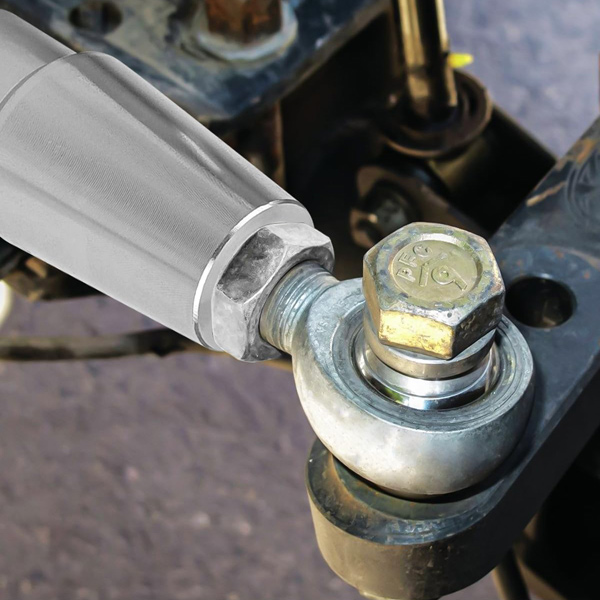Introduction to Rod End Bearings
Rod end bearings, also known as heim joints or spherical bearings, are mechanical components that allow rotational movement between two parts while maintaining a load-bearing connection. They consist of a spherical ball housed in a casing, allowing angular movement while minimizing friction and wear. These bearings are widely use in industries where precise motion control, high load capacity, and durability are essential.
Common Applications:
- Automotive: Suspension linkages, steering components, drive shafts
- Industrial: Machinery, conveyors, robotic arms
- Aerospace: Flight controls, landing gear systems, actuators
Rod end bearings are designed to withstand harsh conditions, making them ideal for dynamic systems requiring flexibility and strength.
Types of Rod End Bearings
Rod ends come in a variety of types, tailored to meet specific application requirements.
Male and Female Rod Ends:

Male Rod End Bearing
These feature external threads on the body, which screw into a mating part with internal threads.

Female Rod End Bearing
These have internal threads on the body, designed to accommodate a male-threaded shaft or rod.
Choosing Between Male and Female: The selection depends on the design of your system. Male rod ends are typically use when attaching to a female component, and vice versa.
Different Materials:

Stainless Steel Rod Ends
Ideal for corrosive environments, stainless steel rod ends offer excellent corrosion resistance and strength, making them suitable for food processing, marine, and outdoor applications.

Steel Rod End Bearing
Commonly use for high-strength applications. Steel rod ends can withstand significant forces but may be prone to corrosion in certain environments.

Bronze Rod End Bearing
Known for their self-lubricating properties and resistance to wear. Bronze bearings are commonly use in low-speed applications or when high durability is required.

Composite Rod Ends
Often use in lighter-duty applications where weight reduction is critical.
Sealed vs. Open Designs:

Sealed Rod Ends
These feature seals or dust covers to protect the bearing from contaminants such as dirt, moisture, and dust. They are perfect for high-performance or harsh environment applications.

Open Rod Ends
These designs do not have protective seals, allowing for easy lubrication and maintenance. They are typically use in applications where exposure to contaminants is minimal.
Features and Benefits of Rod End Bearings

Rod ends are engineered to provide numerous advantages in demanding applications:
- High Load-Bearing Capacity: They can handle substantial loads in both static and dynamic conditions.
- Angular Movement Flexibility: With their spherical design, rod end bearings provide smooth rotation and angular movement, often with a large range of motion.
- Smooth Operation with Minimal Friction: The spherical ball design minimizes friction, allowing for smooth motion even under load.
- Durability and Longevity: High-quality materials and construction ensure that rod end bearings are long-lasting and able to perform in harsh operating conditions.
- Compact and Versatile Design: Their compact size and versatile mounting options make them ideal for a wide range of applications, from tight spaces to large machinery.
Applications of Rod Ends
Rod end bearings are integral components in various industries due to their robustness and flexibility. Here are some key sectors where they are commonly used:
Automotive Industry: Rod ends play a critical role in vehicle suspension systems, steering linkages, and drive shafts. Their ability to handle high loads and rotational movement makes them indispensable in maintaining vehicle stability and comfort.
Industrial Applications: From conveyor systems and lifting equipment to robotic arms, rod end bearings provide smooth and precise movement in machinery. Their ability to resist wear and handle high loads makes them essential in manufacturing and automation.
Aerospace: In the aerospace industry, rod end bearings are use in critical components such as flight control systems, actuators, and landing gear. They are built to withstand extreme conditions, including high speeds and temperature variations.
Agriculture and Construction: Heavy machinery and equipment use in construction and agriculture rely on rod end bearings for their durability and performance. These bearings are use in equipment arms, lifting devices, and other critical components that need to bear heavy loads and maintain flexibility.

Why Choose Our Rod End Bearings?
High-Quality Materials and Manufacturing Standards
Competitive Pricing
Global Reach with Fast Delivery
Durability and Performance
Expertise and Custom Solutions
Technical Support and After-Sales Service
Frequently Asked Questions (FAQ)
- What is the difference between a male and female rod end bearing?
A male rod end bearing has external threads that screw into a mating part with internal threads, while a female rod end bearing has internal threads that fit onto a male-threaded shaft or rod. The choice between the two depends on the design of the system in which they are used.
- How do I determine the correct size of a rod end bearing for my application?
To choose the correct size, you need to consider the following factors: the shaft diameter (for proper fit), the load capacity required, the required angular movement, and the environmental conditions (e.g., corrosion, temperature). We can provide assistance in determining the optimal size based on your system specifications.
- Can rod ends be used in outdoor or harsh environments?
Yes, rod end bearings are suitable for harsh environments, especially those made from stainless steel, bronze, or sealed designs. These materials and seals help protect the bearings from moisture, dirt, and corrosion, making them ideal for outdoor, agricultural, and marine applications.
- How long do rod end bearings last, and how can I extend their lifespan?
The lifespan of a rod end bearing depends on the load, environment, and maintenance. Regular lubrication, periodic inspection for wear, and keeping the bearings free from contaminants can significantly extend their lifespan. If any excessive play, noise, or rust is detected, it’s advisable to replace the bearing.
If you have any questions or would like to learn more about our rod end bearings, don’t hesitate to reach out to us.
For technical support or product inquiries, our customer service team is ready to assist you with any questions you may have.